Measuring In-Situ X-ray Scattering of Natural Rubber Biaxial Deformation: A New Equipment for Polymer Studies †
Abstract
:Supplementary Materials
Author Contributions
Funding
Institutional Review Board Statement
Informed Consent Statement
Data Availability Statement
Acknowledgments
Conflicts of Interest

Publisher’s Note: MDPI stays neutral with regard to jurisdictional claims in published maps and institutional affiliations. |
© 2022 by the authors. Licensee MDPI, Basel, Switzerland. This article is an open access article distributed under the terms and conditions of the Creative Commons Attribution (CC BY) license (https://creativecommons.org/licenses/by/4.0/).
Share and Cite
Silva, D.P.d.; Lamolinara, B.; Costa, A.; Gameiro, F.; Pascoal-Faria, P.; Mateus, A.; Martinez, J.C.; Phinyocheep, P.; Amornsakchai, T.; Mitchell, G.R. Measuring In-Situ X-ray Scattering of Natural Rubber Biaxial Deformation: A New Equipment for Polymer Studies. Mater. Proc. 2022, 8, 136. https://doi.org/10.3390/materproc2022008136
Silva DPd, Lamolinara B, Costa A, Gameiro F, Pascoal-Faria P, Mateus A, Martinez JC, Phinyocheep P, Amornsakchai T, Mitchell GR. Measuring In-Situ X-ray Scattering of Natural Rubber Biaxial Deformation: A New Equipment for Polymer Studies. Materials Proceedings. 2022; 8(1):136. https://doi.org/10.3390/materproc2022008136
Chicago/Turabian StyleSilva, Daniel P. da, Barbara Lamolinara, André Costa, Fábio Gameiro, Paula Pascoal-Faria, Artur Mateus, Juan Carlos Martinez, Pranee Phinyocheep, Taweechai Amornsakchai, and Geoffrey R. Mitchell. 2022. "Measuring In-Situ X-ray Scattering of Natural Rubber Biaxial Deformation: A New Equipment for Polymer Studies" Materials Proceedings 8, no. 1: 136. https://doi.org/10.3390/materproc2022008136
APA StyleSilva, D. P. d., Lamolinara, B., Costa, A., Gameiro, F., Pascoal-Faria, P., Mateus, A., Martinez, J. C., Phinyocheep, P., Amornsakchai, T., & Mitchell, G. R. (2022). Measuring In-Situ X-ray Scattering of Natural Rubber Biaxial Deformation: A New Equipment for Polymer Studies. Materials Proceedings, 8(1), 136. https://doi.org/10.3390/materproc2022008136











